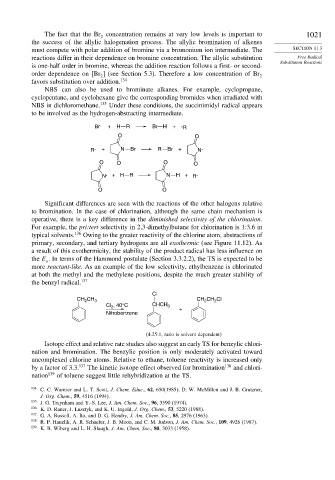Page 1037 - Advanced Organic Chemistry Part A - Structure and Mechanisms, 5th ed (2007) - Carey _ Sundberg
P. 1037
The fact that the Br concentration remains at very low levels is important to 1021
2
the success of the allylic halogenation process. The allylic bromination of alkenes
must compete with polar addition of bromine via a bromonium ion intermediate. The SECTION 11.3
reactions differ in their dependence on bromine concentration. The allylic substitution Free Radical
Substitution Reactions
is one-half order in bromine, whereas the addition reaction follows a first- or second-
order dependence on [Br ] (see Section 5.3). Therefore a low concentration of Br 2
2
favors substitution over addition. 134
NBS can also be used to brominate alkanes. For example, cyclopropane,
cyclopentane, and cyclohexane give the corresponding bromides when irradiated with
NBS in dichloromethane. 135 Under these conditions, the succinimidyl radical appears
to be involved as the hydrogen-abstracting intermediate.
.
Br + H R Br H + . R
O O
R . + N Br R Br + N .
O O O O
N . +H R N H + R .
O O
Significant differences are seen with the reactions of the other halogens relative
to bromination. In the case of chlorination, although the same chain mechanism is
operative, there is a key difference in the diminished selectivity of the chlorination.
For example, the pri:tert selectivity in 2,3-dimethylbutane for chlorination is 1:3.6 in
typical solvents. 136 Owing to the greater reactivity of the chlorine atom, abstractions of
primary, secondary, and tertiary hydrogens are all exothermic (see Figure 11.12). As
a result of this exothermicity, the stability of the product radical has less influence on
the E . In terms of the Hammond postulate (Section 3.3.2.2), the TS is expected to be
a
more reactant-like. As an example of the low selectivity, ethylbenzene is chlorinated
at both the methyl and the methylene positions, despite the much greater stability of
the benzyl radical. 137
Cl
CH CH 3 CH CH Cl
2
2
2
Cl , 40°C CHCH 3 +
2
Nitrobenzene
(4.25:1, ratio is solvent dependent)
Isotope effect and relative rate studies also suggest an early TS for benzylic chlori-
nation and bromination. The benzylic position is only moderately activated toward
uncomplexed chlorine atoms. Relative to ethane, toluene reactivity is increased only
by a factor of 3.3. 137 The kinetic isotope effect observed for bromination 138 and chlori-
nation 139 of toluene suggest little rehybridization at the TS.
134
C. C. Wamser and L. T. Scott, J. Chem. Educ., 62, 650(1985); D. W. McMillen and J. B. Grutzner,
J. Org. Chem., 59, 4516 (1994).
135 J. G. Traynham and Y.-S. Lee, J. Am. Chem. Soc., 96, 3590 (1974).
136
K. D. Raner, J. Lusztyk, and K. U. Ingold, J. Org. Chem., 53, 5220 (1988).
137
G. A. Russell, A. Ito, and D. G. Hendry, J. Am. Chem. Soc., 85, 2976 (1963).
138 R. P. Hanzlik, A. R. Schaefer, J. B. Moon, and C. M. Judson, J. Am. Chem. Soc., 109, 4926 (1987).
139
K. B. Wiberg and L. H. Slaugh, J. Am. Chem. Soc., 80, 3033 (1958).

